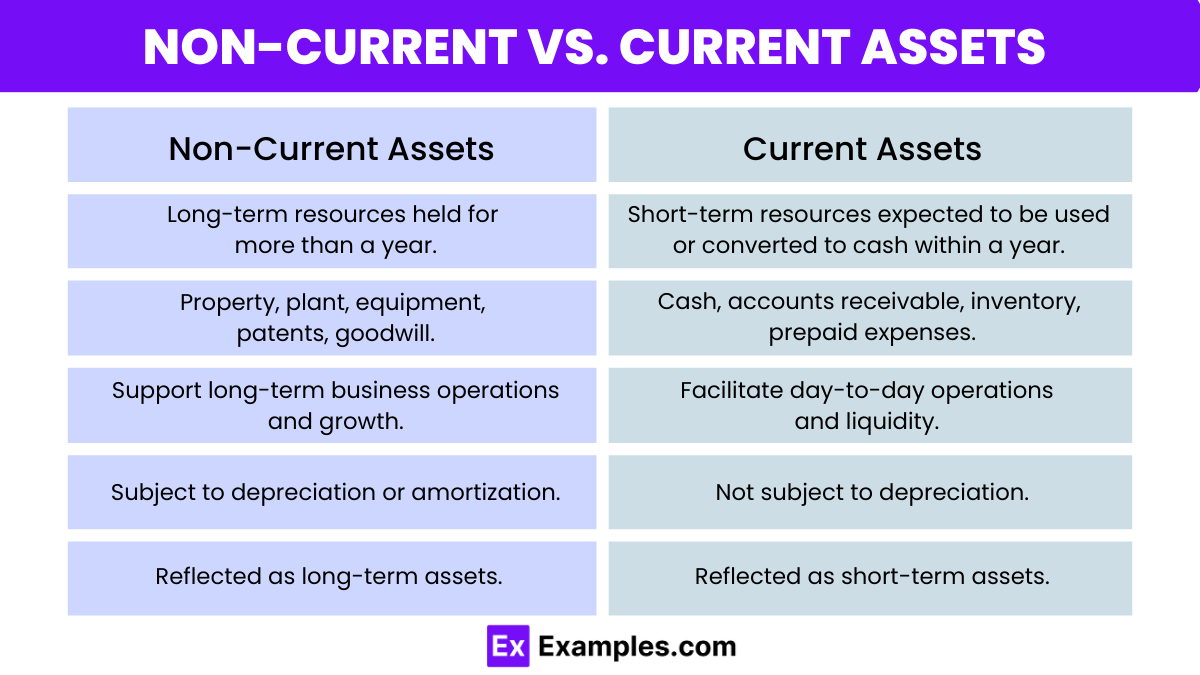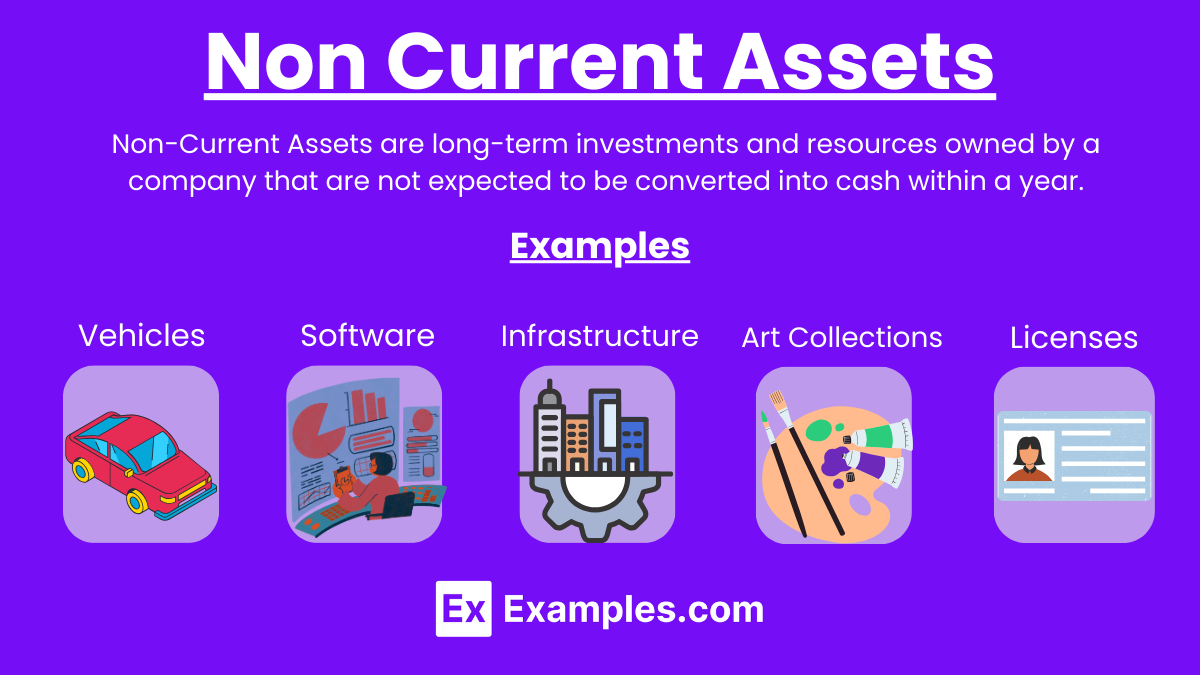25+ Non Current Assets Examples
Non-current assets, also known as long-term assets, are resources a company holds for more than a year and uses in its operations to generate revenue. These include property, plant, equipment, and intangible assets like patents. In contrast, current assets are short-term resources expected to be converted into cash or used up within a year, such as inventory and accounts receivable. Both types of assets, along with liabilities and Inventory Assets (debts and obligations), are critical components of a company’s balance sheet, which provides a snapshot of its financial health at a given point in time.
What are Non Current Assets?
Non-current assets are long-term resources that a company uses in its operations and expects to hold for more than a year, such as property, equipment, and patents. Unlike liquid assets, which are easily converted to cash, non-current assets are part of a company’s broader asset allocation strategy to support long-term growth and stability.
Formula:
How to calculate Non-current assets
To calculate non-current assets, sum up all the long-term assets a company holds. Here’s a step-by-step guide:
- Property, Plant, and Equipment (PPE): Add the value of land, buildings, machinery, and equipment.
- Intangible Assets: Include patents, trademarks, copyrights, and goodwill.
- Long-term Investments: Sum up investments in stocks, bonds, or other securities intended to be held for more than a year.
- Other Long-term Assets: Include items like deferred tax assets, long-term receivables, and any other non-current assets not classified above.
Example Calculation:
Suppose a company has the following items:
- Property, Plant, and Equipment: $200,000
- Intangible Assets: $50,000
- Long-term Investments: $100,000
- Other Long-term Assets: $25,000
Calculation:
Non-Current Assets=200,000+50,000+100,000+25,000 = 375,000
The company’s total non-current assets would be $375,000.
Examples of Noncurrent Assets
- Property: Real estate owned by the company, including land and buildings used for operations or investment.
- Plant: Factories and production facilities where goods are manufactured.
- Equipment: Machinery and tools used in the production process or for providing services.
- Vehicles: Company-owned cars, trucks, and other transportation used for business purposes.
- Furniture: Desks, chairs, and other office furnishings.
- Fixtures: Permanent installations such as lighting and plumbing.
- Computers: Hardware used for business operations.
- Software: Purchased software programs used for business processes.
- Patents: Exclusive rights granted for inventions, allowing the company to produce or sell a product.
- Trademarks: Registered signs, designs, or expressions identifying products or services.
- Copyrights: Legal rights to creative works such as literature, music, and art.
- Franchise Agreements: Rights acquired to operate under a franchisor’s business model and brand.
- Goodwill: Intangible asset arising from the acquisition of one company by another, representing the value of the acquired company’s reputation and customer relationships.
- Long-term Investments: Investments in stocks, bonds, or other securities intended to be held for more than a year.
- Land Improvements: Enhancements to land such as landscaping, fencing, and parking lots.
- Leasehold Improvements: Alterations made to leased property to meet the needs of the business.
- Mineral Rights: Rights to extract minerals from the land.
- Timberland: Land used for growing and harvesting timber.
- Oil and Gas Reserves: Rights to extract oil and gas.
- Art Collections: Valuable works of art owned by the company for display or investment.
- Licenses: Permits acquired to conduct certain types of business or use certain technologies.
- Development Costs: Costs associated with developing new products or services.
- Biological Assets: Livestock or crops that are used in agricultural production.
- Shipping Containers: Containers used for transporting goods over long distances.
- Infrastructure: Long-term physical structures such as bridges, roads, and utilities that support the company’s operations.
Types of Noncurrent Assets
Tangible Assets: Property (land and buildings), plant (factories), equipment (machinery and tools), vehicles (cars and trucks), furniture and fixtures (office furnishings and installations), computers and hardware (IT assets).
Intangible Assets: Patents (legal rights for inventions), trademarks (registered signs/designs), copyrights (rights to creative works), franchise agreements (rights to operate under a franchisor’s model), goodwill (intangible asset from acquisitions), licenses (permits for business activities or technology use).
Financial Assets: Long-term investments (stocks, bonds, securities held for over a year), securities (financial instruments intended for long-term holding).
Natural Resources: Mineral rights (rights to extract minerals), timberland (land for growing/harvesting timber), oil and gas reserves (rights to extract oil and gas).
Development and Capital Projects: Construction in progress (costs of new buildings/facilities), development costs (expenses for new products/services).
Agricultural Assets: Biological assets (livestock or crops used in agricultural production).
Specialized Assets: Art collections (valuable art for display/investment), infrastructure (long-term structures like bridges, roads, utilities).
Non-Current vs. Current Assets

| Aspect | Non-Current Assets | Current Assets |
|---|---|---|
| Definition | Long-term resources held for more than a year | Short-term resources expected to be used or converted to cash within a year |
| Examples | Property, plant, equipment, patents, goodwill | Cash, accounts receivable, inventory, prepaid expenses |
| Purpose | Support long-term business operations and growth | Facilitate day-to-day operations and liquidity |
| Liquidity | Low (not easily converted to cash) | High (easily convertible to cash) |
| Depreciation/Amortization | Subject to depreciation or amortization | Not subject to depreciation |
| Balance Sheet Impact | Reflected as long-term assets | Reflected as short-term assets |
What are non-current assets?
Non-current assets are long-term resources held for over a year, including property, equipment, and intangible assets.
How do non-current assets differ from current assets?
Non-current assets are held long-term, while current assets are expected to be converted to cash within a year.
What are examples of non-current assets?
Examples include property, plant, equipment, patents, and goodwill.
Why are non-current assets important?
They support long-term business operations and growth, providing stability and potential revenue.
Can non-current assets be liquidated?
Yes, but typically non-current assets are less liquid compared to current assets.
How are non-current assets recorded on the balance sheet?
They are listed under long-term assets on the balance sheet.
Do non-current assets depreciate?
Yes, tangible non-current assets like equipment and buildings depreciate over time.
What is amortization of non-current assets?
Amortization refers to the gradual expensing of intangible non-current assets like patents.
How do non-current assets impact financial health?
They indicate long-term investment and stability, crucial for sustaining business operations.
Can non-current assets include investments?
Yes, long-term investments in stocks or bonds are considered non-current assets.


